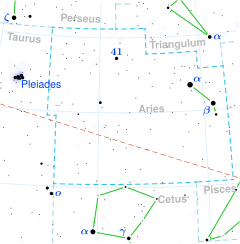41 Arietis (abbreviated 41 Ari) is a triple star system in the northern constellation of Aries. With an apparent visual magnitude of 3.63,[2] this system is readily visible to the naked eye. It has an annual parallax shift of 19.69 mas,[1] which indicates it is at a distance of 166 light-years (51 parsecs) from the Sun.
| Observation data Epoch J2000 Equinox J2000 | |
|---|---|
| Constellation | Aries |
| Right ascension | 02h 49m 59.03324s[1] |
| Declination | +27° 15′ 37.8260″[1] |
| Apparent magnitude (V) | 3.63[2] |
| Characteristics | |
| Spectral type | B8 Vn[3] |
| U−B color index | –0.38[2] |
| B−V color index | –0.10[2] |
| Astrometry | |
| Radial velocity (Rv) | +4[4] km/s |
| Proper motion (μ) | RA: +66.81[1] mas/yr Dec.: –116.52[1] mas/yr |
| Parallax (π) | 19.69 ± 0.19 mas[1] |
| Distance | 166 ± 2 ly (50.8 ± 0.5 pc) |
| Details | |
| Mass | 3.1±0.1[5] M☉ |
| Luminosity | 160[6] L☉ |
| Temperature | 11900[6] K |
| Rotational velocity (v sin i) | 175[7] km/s |
| Age | 130+10 −30[5] Myr |
| Other designations | |
| Database references | |
| SIMBAD | data |
The system consists of a binary pair,[9] designated 41 Arietis A, together with a third companion star, 41 Arietis D. (41 Arietis B and C form optical pairs with A, but are not physically related.[10]) The components of A are themselves designated 41 Arietis Aa (formally named Bharani /ˈbærəni/)[11] and Ab.
Nomenclature
41 Arietis is the system's Flamsteed designation. It does not possess a Greek-letter Bayer designation, since this system was once part of the now-obsolete constellation Musca Borealis, but is sometimes designated c Arietis. The designations of the two constituents as 41 Arietis A and D, and those of A's components - 41 Arietis Aa and Ab - derive from the convention used by the Washington Multiplicity Catalog (WMC) for multiple star systems, and adopted by the International Astronomical Union (IAU).[12]
Nicolas-Louis de Lacaille called the star Līliī Austrīnā (/ɔːˈstraɪnə/) 'southern of Lilium' (in Latin) in 1757,[13][14] as a star of the now-defunct constellation of Lilium (the Lily). To him 39 Arietis was Līliī Boreā, 'northern of Lilium'.
In Hindu astronomy, Bharani (भरणी bharaṇī, Sanskrit pronunciation: [ˈbʱɐɽɐɳiː]) is the second nakshatra, or lunar mansion corresponding to 35, 39 and 41 Arietis. In 2016, the IAU organized a Working Group on Star Names (WGSN)[15] to catalog and standardize proper names for stars. The WGSN decided to attribute proper names to individual stars rather than entire multiple systems.[16] It approved the name Bharani for the component 41 Arietis Aa on 30 June 2017 and it is now so included in the List of IAU-approved Star Names.[11]
In Chinese, 胃宿 (Wèi Su), meaning Stomach (asterism), refers to an asterism consisting of 41, 35 and 39 Arietis.[17] Consequently, the Chinese name for 41 Arietis itself is 胃宿三 (Wèi Su sān, English: the Third Star of Stomach.)[18]
In Avestan, the star was known as Upa-paoiri, and it was associated with one of the yazatas.[19]
Properties
The primary component is a B-type main sequence star with a stellar classification of B8 Vn.[3] The suffix 'n' indicates 'nebulous' absorption lines in the star's spectrum caused by the Doppler effect of rapid rotation. It has a projected rotational velocity of 175 km/s.[7] This is creating an equatorial bulge that is 12% larger than the star's polar radius.[20] It is a candidate member of the AB Doradus moving group[6] and has an orbiting companion at an angular separation of 0.3 arcseconds.[9]
